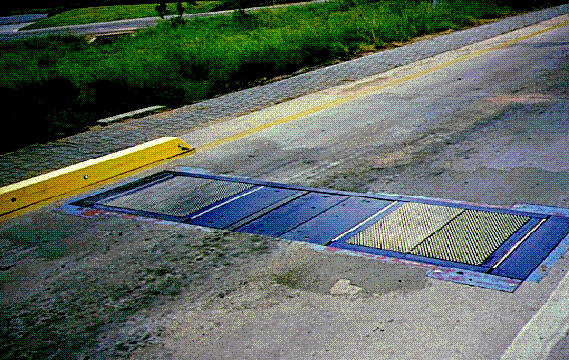|
Researchers at the CSIR have developed a Vehicle-Road Surface
Pressure Transducer Array (VRSPTA) system to measure tyre/road interface
stresses under a moving pneumatic wheel load, including that of an
aircraft. This unique system simultaneously measures the vertical,
transverse and longitudinal vehicle tyre/road interface stresses - some
of the most important inputs into pavement design for optimising the
cost of roads over their design life. This technology is referred to as
the Stress - In - Motion (SIM) technology.
The various SIM system consists of an array of calibrated
strain-gauged steel pins fixed to a steel base-plate buried in the
surface of the road. These load cell pins are installed at right angles
to the direction of travel. The strain outputs from these pins are
scanned at a high rate while the wheel traverses the pins, giving an
indication of the vertical, transverse and longitudinal loads acting on
each pin. The system is approximately 750 mm long by 360 mm wide and 108
mm high, and the tyre loads and load distributions are measured over the
complete tyre contact area.
Often, and certainly in southern Africa, the cost of the
asphalt layers dominates the cost of road construction and maintenance.
Therefore, it is important to design towards an optimum asphalt layer
thickness in relation to the supporting road structure, and the expected
axle loading and tyre pressures for a particular road.
Usually static uniform tyre contact stress distribution is
assumed to simulate tyre/road interface vertical stresses as input
towards the design and evaluation of the road structure. While this
approach maybe adequate for relatively thick (>75 mm) asphalt
surfacing and base layers, it is highly inaccurate for thinner layers.
Horizontal tensile strains resulting from a non-uniform stress
distribution can be up to 100 per cent higher than with a uniform stress
distribution, indicating the potential of premature failure of the
asphalt surfacing.
For thicker asphalt layers the potential for permanent
(plastic) deformation is also closely related to actual tyre/road
contact stresses. It is therefore critical to ensure the accurate
quantification of the actual stresses at the tyre/road interface.
To this end, the accelerated pavement testing (APT) programme
at the CSIR included the experimental design of the Vehicle-Road Surface
Pressure Transducer Array (VRSPTA) system. The first prototype (VRSPTA
Mark I) was developed in association with the Laboratory of Advanced
Engineering (Pty) Ltd (LGI), Centre for Structural Mechanics, University
of Pretoria. The CSIR then upgraded the system to a stand-alone unit (VRSPTA
Mark II), which simultaneously measures stresses in the three directions
and acquires data for wheel speeds up to 10 km/h. Further development
lead to a 4-pad VRSPTA Mark III system which is able to measure the full
axle of real world trucks.

VRSPTA
Mark I
(Single Tyre)

VRSPTA Mark II
(Single
Tyre)

VRSPTA Mark III (Full Axle)
Some information and results on the VRSPTA Mark III can be
found in the following paper, published at the Conference on Asphalt
Pavements in Southern Africa, 1999:
“Towards
improved mechanistic design of thin asphalt layer surfacings based on
actual type/pavement contact stress-in-motion data in South Africa” by
De Beer M, Kannemeyer L and Fischer
C.
Initial results from the VRSPTA systems indicate that, in
extreme cases, the tyre side wall vertical stresses can be twice as high
as the tyre inflation pressure, and that the maximum transverse stresses
can exceed the inflation pressure by as much as 27 per cent. The maximum
longitudinal stresses appear to be the lowest of the three stresses - at
maximum only 30 percent of the tyre inflation pressure. The results
appear to be promising in evaluating tyre/road interface stress patterns
with the current VRSPTA systems and have proved the viability of the SIM
concept.
Our organization’s
main web page is as follows: http://www.csir.co.za.
Once there, click on Built Environment |
